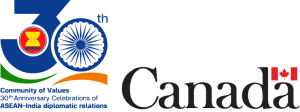


Ms. Zailina Abdul Majid heads the Task Force on the Development of ASEAN Food Safety Regulatory Framework (TF AFSRF), comprising ASEAN officials in the health, agriculture, and trade sectors. The task force will recommend measures to harmonise food safety requirements in the region. Its work will conclude upon the ratification of the AFSRF by all ASEAN Member States, paving the way for the formation of the ASEAN Food Safety Coordinating Committee. This Committee will then take the lead in overseeing the AFSRF's implementation and its protocols. Ms. Zailina discusses the challenges and successes in working across sectors to strengthen ASEAN's food safety policy with The ASEAN.

Food Safety is a complex issue. It cuts across sectors such as agriculture, trade, and health. Although each sector has its own food safety initiatives within its scope of work, there was not enough coordination to facilitate cross-sectoral activities.
With the ASEAN Food Safety Policy, we have established the basis for coordination across relevant sectors, i.e. the ASEAN Health Ministers Meeting (AHMM) for the health sector, ASEAN Ministers on Agriculture and Forestry (AMAF) for the agriculture sector, and the ASEAN Economic Ministers (AEM) for the trade sector.
The Prepared Foodstuff Product Working Group (PFPWG) led the development of the ASEAN Food Safety Policy—together with the then ASEAN Expert Group on Food Safety which is now called ASEAN Health Cluster 4: Ensuring Food Safety under the health sector and AMAF working groups— basically to protect consumers’ health and ensure best practices in the food trade, facilitating the movement of safe food products across the ASEAN region.
The basic principle of the ASEAN Food Safety Policy is to have an integrated food chain approach, meaning food safety is considered throughout the entire food supply chain, from farm to table. It underlines 10 key principles to ensure food safety, from production to consumption. These include emphasising a systematic risk analysis framework, a science-based approach, and promoting the harmonisation of standards with international standards. So, these principles cannot be addressed by a single sector alone, and coordination is needed among all three sectors involved in food safety. This is what prompted ASEAN to establish a food safety policy.
The next step was how to implement that policy. Thus, the ASEAN Food Safety Regulatory Framework was developed to support its implementation by all ASEAN Member States. It is a comprehensive and integrated overall approach towards food safety that will help protect consumers’ health and facilitate food trade.
Why was it necessary to have a food safety policy, regulatory framework, and agreement in ASEAN?
The ASEAN Member States have their own technical requirements and food safety control systems. When the PFPWG started the work to harmonise food safety standards, it noted the gaps in technical requirements among the Member States. To have the same standards for food safety, we agreed to use the Codex* standards as a benchmark for harmonising the Member States’ technical regulations with international standards. Adopting the same food safety standards across the Member States will facilitate food product trade, import, and export.
In ASEAN, sectoral working groups develop various food safety initiatives within their scope of work. How will we utilise and optimise these initiatives or institutions developed by ASEAN without replicating or duplicating the work that other sectors have already done? This is why we use the existing initiatives developed by each sectoral body in ASEAN, ensuring a level playing field. As a result, we will be better prepared for any situation, especially in the trade sector.
The ASEAN Food Safety Regulatory Framework Agreement consolidates what we have in ASEAN. For example, in agriculture, we have the ASEAN Rapid Alert System for Food and Feed (ARASFF) as a portal for alerts and notifications on rejected foods, which will be utilised for food safety emergencies. Under the PFPWG, there is ongoing work on food safety harmonisation. In the health sector, the ASEAN Risk Assessment Centre for Food Safety (ARAC) supports regional food safety risk assessments, including those for harmonisation purposes. We encourage sectoral working groups to use the ARAC for any harmonisation work if you need data to be established among ASEAN Member States.
Are these agreements binding, and how will the framework agreement be implemented?
Several guidelines and standards have already been established among ASEAN Member States, but the current implementation is voluntary. The ASEAN Food Safety Regulatory Framework Agreement makes specific agreed initiatives mandatory through the development of protocols. So, Member States need to follow the agreement. All 10 Member States have fully signed the agreement and are now in the ratification process. We expect it to be ratified by all 10 Member States by this year. That is the target.
I can also share with you what the task force has agreed on, such as the use of food additives in ASEAN. Under the work of PFPWG, we have a list of harmonised food additives in ASEAN. For now, the food additive list is used voluntarily as a reference by the ASEAN Member States. When we agree to include these food additives in the protocols, it will be mandatory for all ASEAN Member States to use these food additive standards.
What kind of risks do we face as a region regarding Food Safety?
Under ARASFF, they have a system: if the product coming from the ASEAN Member States enters one country, and they find it contravening the regulation or requirements of that country, the system will alert the other Member States that this shipment has been violating the country’s regulation. At the moment, we only share information about contraventions related to food safety. For example, when there is misuse of pesticides or the level of contaminants exceeds the maximum residue limits permitted by Member States, the information will be shared through the system. Other countries can then check if the same non-compliant product is coming into their borders.
What we are looking at is not only the entry point, but also if there are any food emergency incidents. For example, if there is any contamination in one country, this information should be shared to prevent the importation of contaminated food by other countries. It is similar to what the Food and Agriculture Organization and World Health Organization International Food Safety Authorities Network (INFOSAN) do to alert countries about food safety emergencies. However, it is still under discussion if we want it to become mandatory. Some Member States already have these emergency plans in place if any crisis or food safety incident happens in their country, but we have not linked these at the regional level.
What are the next steps after ratifying the ASEAN Food Safety Regulatory Framework Agreement?
Upon entry into force, the ASEAN Food Safety Coordinating Committee (AFSCC) will be established, consisting of top management officials in food safety from agriculture, trade and health in the same committee. The AFSCC will manage cross-sectoral food safety activities but the implementation will be delegated to the relevant sector.
For example, if we want to make emergency response mandatory across Member States, we may want the agriculture and health sectors to work together. The coordination will still be established under the AFSCC, involving all three sectors. At the ASEAN Secretariat, there is a cross-sectoral secretariat on food safety.
The current Task Force on the Development of AFSRF will be dissolved upon establishing the AFSCC, and the senior officer-level representatives of each sector from each Member State will be part of the decision-making process.
What achievements have been made in ensuring food safety from farm to table, and what challenges remain?
stakeholders with shared objectives. We recognise that the agriculture, health, and trade sectors possess distinct scopes of work and targets. Therefore, achieving a unified engagement is difficult, especially given that the financial limitations of Member States often prevent cross-ministerial participation in relevant discussions. For instance, within the ASEAN Member States, food safety oversight varies, with some ASEAN Member States placing it under the Ministry of Health, others under the Ministry of Agriculture or the Ministry of Industry.
The most significant achievement is the signing of the AFSRF Agreement. This agreement, involving agriculture, health, and trade sectors, obligates members to adhere to agreed-upon ASEAN-level standards. Previously, while many works existed for harmonisation and trade facilitation, they lacked mandatory implementation, resulting in inconsistent adoption.
This agreement will ensure consistent implementation of developed protocols across all Member States. Each Member State invests considerable effort, time, and resources in developing harmonisation of food safety standards. However, without mandatory implementation, these efforts are not fully realised. Establishing this agreement represents the most significant achievement for the ASEAN Member States collaborating across agriculture, trade, and health sectors to ensure safe food trade and consumer health protection for the ASEAN population.
On another note, under the PFPWG, we have also established a Mutual Recognition Arrangement for Food Inspection and Certification on Food Hygiene for Prepared Foodstuff Products, the MRA on PF. This initiative aims to facilitate trade among ASEAN Member States by obliging them to follow the food control system established by Codex, so that food hygiene requirements are harmonised across all Member States. It is not explicitly mentioned in the MRA, as in the framework agreement involving trade, health, and agriculture. However, since food safety is governed under different ministries in most of the ASEAN Member States, implementing this MRA more or less involves all the relevant ministries of each Member State. They are involved according to their respective jurisdictions. It is not as structured as the Food Safety Regulatory Framework Agreement, but it requires cross-sectoral collaboration within the Member States at the national level to facilitate trade. This one has been put into force, and we are now working on the implementation mechanism.
*The Codex Alimentarius or “Food Code” is a collection of standards, guidelines and codes of practice adopted by the Codex Alimentarius Commission. Codex standards ensure that food is safe and can be traded.






